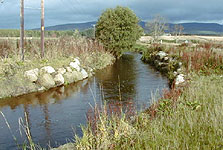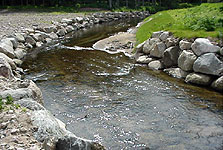Our rivers and burns contribute much to the character and industry of Aberdeenshire. They provide us with water to drink, an essential resource in terms of agriculture, industry, commerce (angling and the tourist trade), natural habitats and an ever present refuge from the stresses and strains of contemporary life. All this highlights the importance of ensuring we manage our watercourses and their floodplains in a manner that conserves those qualities, as well as utilising their potential in a sustainable manner.
Even when management works or development in or near a river or burn has been carefully thought out and executed, there may be a knock on effect on stretches outwith the immediate area of the work and sometimes at a considerable distance. Erosion may be accelerated in some areas and displaced material may affect water quality, damage spawning grounds, infill pools and result in siltation elsewhere. Such effects can alter the natural function of the river system and threaten and disturb wildlife.
In addition to the potential for detrimental impact on the biodiversity and morphology of the area there is also a potential for causing flooding through lack of consideration of the overall effect on a watercourse. For example, building flood banks may protect those in the immediate vicinity from flooding but it may also shift the problem downstream to affect others. In addition, although flood banks will hold back flood waters to a certain extent, once overtopped, the banks can trap water behind, leaving land flooded and useless for weeks rather than hours. Working with, rather than against, rivers can reduce the need for, and the scale of, intervention and can deliver cost-effective and long-lasting solutions to land and river management problems such as bank erosion.
Consultation – When planning any works in or on land adjacent to watercourses, you should consider what permissions, consents, notifications or consultations are necessary. Aberdeenshire and Aberdeen City Council have produced a Guidance Note to assist in the planning and development of works next to watercourses. When considering work, do some research and consult others to get an idea of the history of the area. It may well be that others have tried similar work in the past and their experiences could be invaluable to you.
Legislation – The range of legislation and regulations that apply to works on and around watercourses are detailed in this Guidance Note. You should be aware that the forthcoming requirements of the EU driven Water Framework Directive will lead to changes in these guidance notes. Follow the link to see SEPA’s interim policy guidance note on engineering operations.
Other useful links and publications that help guide development in and around watercourses include:
- Riparian Management. We apologise that this link is currently unavailable but should be added soon. For a copy of the leaflet please e-mail Linda.Mathieson@aberdeenshire.gov.uk





